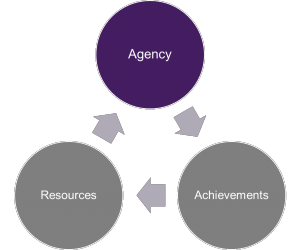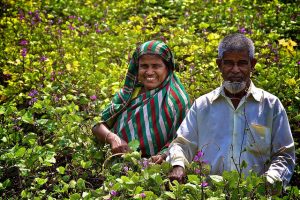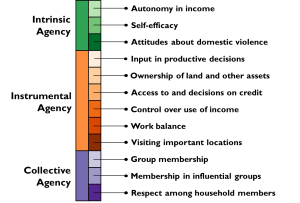In April 2018, the Gender, Agriculture, and Assets Project, Phase 2 (GAAP2), launched the pilot version of the Project-Level Women’s Empowerment in Agriculture Index (pro-WEAI). Pro-WEAI is a new survey-based index for measuring empowerment, agency, and inclusion of women in the agriculture sector. Developed jointly by the International Food Policy Research Institute (IFPRI), the Oxford Poverty and Human Development Initiative (OPHI), and thirteen partner projects in the GAAP2 portfolio, the tool helps agricultural developmental projects assess women’s empowerment in a project setting, diagnose areas of women’s disempowerment, design strategies to address deficiencies, and monitor project outcomes. Pro-WEAI is an adaptation of the Women’s Empowerment in Agriculture Index (WEAI), originally developed in 2012 by IFPRI, the United States Agency for International Development (USAID), and OPHI.
What is pro-WEAI?
Pro-WEAI is composed of 12 indicators of women’s empowerment in agriculture: autonomy in income, self-efficacy, attitudes about domestic violence, input in productive decisions, ownership of land and other assets, access to and decisions on credit, control over use of income, work balance, visiting important locations, group membership, membership in influential groups, and respect among household members. These indicators are organized into three domains: intrinsic agency (power within), instrumental agency (power to), and collective agency (power with).
A respondent is considered adequate in a particular indicator if she or he reaches a certain threshold. For example, a respondent is adequate in group membership if she or he is an active member of at least one group in the community. The indicators are weighted equally, and a respondent is considered empowered if she or he is adequate in at least 75 percent – or at least 9 out of 12 – of the indicators.
The Three Domains of Empowerment score (3DE) is calculated from these 12 indicators, and reflects how many respondents are empowered across the three domains and the extent of their empowerment. Pro-WEAI is a composite index that tells us how empowered the women surveyed are as a group. Pro-WEAI combines the 3DE score with the Gender Parity Index (GPI), which assesses how empowered women are in comparison with the men in their households.
How is pro-WEAI different from WEAI?
The original WEAI and abbreviated WEAI (A-WEAI) are based on five domains of empowerment: production, resources, income, leadership, and time. In pro-WEAI, we measure many of the same areas of empowerment, but organize them into domains that are more explicitly based on the existing literature on empowerment. Naila Kabeer describes empowerment as a dynamic process: resources enable women to have agency, or the ability to make decisions, through which women can achieve outcomes. The three domains of empowerment of pro-WEAI focus on measuring three types of agency: intrinsic agency (power within), instrumental agency (power to), and collective agency (power with).

Naila Kabeer conceptualizes empowerment as a process of change made up of three interrelated dimensions: resources, agency, and achievements.
Pro-WEAI includes new indicators of empowerment that were not part of WEAI, assessing areas such as self-efficacy, domestic violence, mobility, and intrahousehold relationships. Further, many of the indicators of pro-WEAI have stricter cutoffs for adequacy than WEAI to allow for projects to detect changes in empowerment over time. For example, in WEAI, a respondent is considered adequate in control over use of income if she or he has input in decisions about at least one source of income. In pro-WEAI, a respondent is considered adequate in this indicator if she or he has input in decisions about income from all of the income-generating activities in which she or he participates.
Pro-WEAI is intended to measure changes in women’s empowerment over the course of an agricultural development project, and it focuses on indicators of empowerment that a project could change. In addition, pro-WEAI includes optional add-on modules to look at women’s empowerment in projects that focus on outcomes related to nutrition, health, and livestock.
What’s next for GAAP2 and pro-WEAI?
Pro-WEAI was developed and tested using baseline data collected by nine partner projects in the GAAP2 portfolio. Partner projects are now designing their endline surveys in which pro-WEAI will be fielded again. Analyzing pro-WEAI baseline and endline data in each of the participating projects will enable us to assess their impact on women’s empowerment. In the meantime, the GAAP2 index development team is using the projects’ pilot data, results, and insights to continue to test and refine the new index.
References:
- Kabeer, N. 1999. Resources, agency, achievements: Reflections on the measurement of women's empowerment. Development and Change, 30(3), 435-464.
Previous blogs about pro-WEAI:
- Hannan A. 2018. How can you tell if your survey questions work? Using cognitive testing to improve measurement of women’s empowerment in nutrition and health.
- Martinez E. 2017. Progress in designing and implementing the project-level WEAI.
- Heckert J and Kim S. 2016. Developing a nutrition-sensitive pro-WEAI.
- Balagamwala M. 2016. Development of a project-level WEAI begins at the GAAP2 inception workshop.
The Gender, Agriculture, and Assets Project, Phase 2 (GAAP2) is led by IFPRI in collaboration with OPHI and funded by the Bill & Melinda Gates Foundation, the United States Agency for International Development, and the CGIAR Research Program on Agriculture for Nutrition and Health. Visit the GAAP2 website to learn more about GAAP2 and the WEAI Resource Center to learn more about pro-WEAI and other versions of WEAI.

